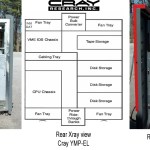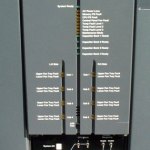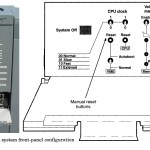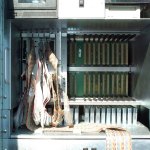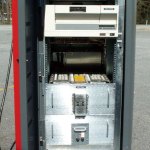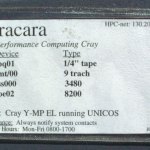Cray EL

The Cray-YMP EL range of computers were manufactured from 1992 until 1996. A direct development of the XMS project this range included the smallest and cheapest systems delivered to customers.
The EL was a clone of the YMP architecture implemented in CMOS technology and used a VME bus I/O subsystem. Most importantly the EL range used the same UNICOS operating system and development programming environment as the full size machines.

Starting with two chassis sizes with max 4 and 2 cpus the EL range was doubled up in ’93 to become max 8 and 4 cpus with more memories. Initially named Cray YMP–EL upgraded range was known as the Cray EL90 range. The EL92 and EL94 being the small cab versions.
This air cooled minisuper later evolved into the Cray EL94 and EL98 using mother/daughter CPU and larger memory boards included the following standard equipment.
- VMEbus input/output subsystem (IOS)
- IOS disk drive
- Tape drive Qic and later DAT
- Ethernet controller
- System console Wyse terminal
- Maintenance workstation
- High-performance modem
| Model | EL/1-256 | EL/1-256 | EL/1-1024 | EL/2-256 | EL/2-512 | EL/2-1024 | EL/4-256 | EL/4-512 | EL/4-1024 |
| CPUs | 1 | 1 | 1 | 2 | 2 | 2 | 4 | 4 | 4 |
| Memory Size | 32M | 64M | 128M | 32M | 64M | 218M | 32M | 64M | 128M |
| IOSs | 1..4 | 1..4 | 1..4 | 1..8 | 1..8 | 1..8 | 1..16 | 1..16 | 1..16 |
The EL90 series evolved from the Cray Y-MP EL minisupercomputer, and is compatible with Y-MP software, running the same UNICOS operating system. The range comprised three models:
- EL92, with up to two processors and 64 megawords (512 MB) of DRAM in a deskside chassis: dimensions 42×23.5×26 inches or 1050×600×670 mm (height × width × depth) and 380 lb/172 kg in weight.
- EL94, with up to four processors and 64 megawords (512 MB) of DRAM, in the same cabinet as the EL92.
- EL98, a revised Y-MP EL with up to eight processors and 256 megawords (2 GB) of DRAM in a Y-MP EL-style cabinet (62×50×32 inches or 2010×1270×810 mm, 1400 lb/635 kg in weight).
The EL90 series Input/Output Subsystem (IOS) was based on the VMEbus and a Heurikon HK68 Motorola 68000-based processor board (or IOP). The IOP also provided the system’s serial console. All EL90 models could be powered from regular mains power.
The EL90 series was superseded by the Cray J90 series.
VectorMonster_EL92 review paper
Sales brochures :
Technicalical manuals specific to this machine :
- CRAY EL92 and CRAY EL94 Systems Overview Manual
- HR-04026-0B-Preparing_Your_Site_for_a_CRAY_Y-MP_EL_or_CRAY_EL98_Installation-July_1994
- SG-5201_7.0_UNICOS_Installation_Guide_for_Cray_Y-MP_EL_Computer_Systems_Jan93
- SG-2416_9.0_DUP EL Basic Administration guide for J90 and EL – This manual was of specific importance to EL customers as it described how to administrate and operate the EL instead of the usual list of technical descriptions of commands.
- CMM-0431-000 YMP–EL trouble shooting
- HR-04027 CRAY Y-MP EL Functional Description
- Cray YMP–EL MiscServiceNotes
- CQQ-0707 CRAY YMP–EL and CRAY EL98 parts_catalog
- SQ-2162_80 CRAY EL series IOS Command Redy Reference
Mid-life Kicker
CRAY RESEARCH ANNOUNCES NEW ENTRY-LEVEL
SUPERCOMPUTER SYSTEM
CRAY EL98 Doubles Price Performance of Previous System
EAGAN, Minn., March 30, 1993 — Cray Research (NYSE:CYR)
today unveiled the CRAY EL98 supercomputer system, an
enhanced successor to the company’s strong-selling CRAY
Y-MP EL entry-level supercomputer system.
The new CRAY EL98 system provides twice the peak
performance of the CRAY Y-MP EL configurations at the
same prices, according to Robert Ewald, general manager of
supercomputer operations and executive vice president of
Cray Research. The new system also offers four times the
central memory capacity of the CRAY Y-MP EL system.
Pricing for a two-processor CRAY EL98 system begins at
$340,000 in the U.S., the same starting price as for a
one-processor CRAY Y-MP EL system, he said.
The new system is available with two, four, six, or eight
processors. Ewald said the largest configuration contains
eight processors and 4,096 megabytes (512 million words)
of central memory, providing a peak performance of one
gigaflops (billion floating point operations per second).
Larger memory makes it possible to tackle larger problems,
or to solve existing problems faster.
“The EL98 system supports high sustained performance
with a balanced architecture that provides 4.2
gigabytes/second of total memory bandwidth and 1.05
gigabytes/second of I/O (input-output) bandwidth,” Ewald
said.
The CRAY EL98 system uses the same chassis as Cray
Research’s previous entry-level system, Ewald said. By
adding or exchanging modules, existing CRAY Y-MP EL
customers can easily upgrade the processing power of their
systems in the field.
In 1992, the company’s first full year in the entry-level
supercomputing market, Cray Research booked orders for
130 CRAY Y-MP EL systems, exceeding its original target of
100 orders for the year, according to Ewald. Cray
Research’s entry-level systems have brought in more than
70 new-to-Cray Research customers in the aerospace,
automotive, chemical, financial, construction, utilities, and
electronics industries, as well as universities and
environmental and general research centers. Cray Research
will continue its long-term commitment to entry-level
products with a project aimed at delivering the
next-generation system in the second half of 1994. This
entry-level system will be based on aggressive CMOS
integrated circuit technology and provide substantial speed
and performance gains.
Orders for five CRAY EL98 systems have already been
received, Cray Research said. The new system runs on
standard 200-240 volt, single-phase power and can easily
be installed virtually anywhere, including on ships, at
remote processing sites, or in an office environment. Both
50 hertz and 60 hertz power are supported to allow
installation worldwide.
The new system is binary-compatible with the company’s
full line of CRAY Y-MP, CRAY Y-MP M90, and CRAY C90
supercomputer systems, Ewald said. As problem complexity
increases, he said, a CRAY EL98 application can readily be
scaled to run on any of the larger systems. More than 600
leading software applications currently available on these
systems, and on the original CRAY Y-MP EL supercomputer,
will operate without modification on the CRAY EL98
system. The new system runs Cray Research’s UNICOS 7
(UNIX-based) operating system, and CF77 Fortran and Cray
Standard C compilers.
Cray Research creates the most powerful, highest-quality
computational tools for solving the world’s most
challenging scientific and industrial problems.
###
EL92 Announcement
RAY RESEARCH ANNOUNCES COMPATIBLE DESKSIDE
SYSTEM FOR APPLICATIONS DEVELOPMENT
EAGAN, Minn., July 20 — Cray Research, Inc. (NYSE:CYR) today
announced the CRAY EL92 deskside computer system, the
company’s smallest, lowest-priced system to date. The new
product, scheduled for fourth-quarter availability, will be sold
primarily as an applications development platform for the
company’s full line of CRAY C90 parallel vector supercomputer
systems, as well as for the CRAY T3D, Cray Research’s first
massively parallel processing (MPP) system due out later this
year.
“With a U.S. starting price of $125,000 and a footprint of about
four square feet, the CRAY EL92 is designed to extend Cray
Research compatibility to office environments at attractive
prices,” said Derek Robb, Cray Research director of sales and
marketing support. The new system, he said, uses the same
technology as the company’s CRAY EL98 entry-level
supercomputer series, the company’s previously lowest-priced
computers that begin at under $350,000 in the U.S.
By using the CRAY EL92 for applications development,
customers can reserve their larger Cray Research systems for
solving complex problems and handling interactive workloads,
he said. According to Robb, the new system can also be used to
offload smaller problems currently running on the large
systems; as a low-cost, high-performance network node for
vector and parallel applications; to run pilot simulations of
large jobs destined for more powerful Cray Research systems;
and as a “network resource broker” using Cray’s Network
Queuing Environment (NQE) product.
The CRAY EL92 is available with one or two CPUs, and 256 to
512 megabytes (32 to 64 megawords) of real main memory, he
said. The air-cooled system operates on standard 50 Hz and 60
Hz power, and can easily be installed by customers in office
environments. It is offered with a fast HIPPI interface for
network connectivity applications such as Parallel Virtual
Machine (PVM), or to speed transfers of large datasets to CRAY
90 and CRAY T3D systems, Robb added.
Robb said the new system runs more than 600 applications
currently operating on larger Cray systems and includes the
company’s industry-leading UNICOS operating system, which is
UNIX-based and POSIX-compliant. “The CRAY EL92 system
includes the same operating system, programming
environments, compilers and networking capabilities as more
powerful Cray Research Systems.” In addition, he said, the
system can also be ordered with the CRAY T3D Emulator, a
software tool that helps programmers using the CF77
programming environment to develop and test applications for
the CRAY T3D massively parallel system.
The CRAY EL92 can be clustered with each other, or with a
CRAY Y-MP, CRAY C90 or CRAY T3D system, and applied to a
single job using PVM software, he said. The system can
operate compatibly with non-Cray systems in heterogeneous
networks because of its adherence to industry standards in its
operating system, programming languages (Fortran 77, C, C++),
networks (HIPPI, FDDI, Ethernet), and distributed computing
environments (PVM, RQS/NQS, NQE), he said.
The new system will be sold by Cray Research, he said. UL
approval is expected prior to shipment.
Cray Research creates the most powerful, highest-quality
computational tools for solving the world’s most challenging
scientific and industrial problems.
###
—
— Conrad Anderson
Employee Communications










